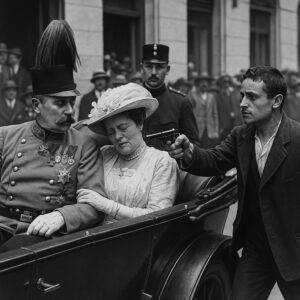On July 5, 1786, two unlikely heroes—Jacques Balmat, a young chamois hunter, and Dr. Michel-Gabriel Paccard, a local physician—did something that would change the history of exploration forever. They stood atop Mont Blanc, the highest peak in Western Europe, at an elevation of 4,808 meters (15,774 feet). Their ascent was more than just a physical triumph—it was a symbolic moment that marked the beginning of modern mountaineering and redefined the boundaries of human endurance, ambition, and scientific curiosity. The summit had been a white crown resting untouched in the French Alps for centuries, admired from afar, feared by many, and believed to be impossible to reach. But on that summer day in 1786, the impossible became reality, and the world took its first step into the high-altitude frontier.
To understand the importance of their climb, you must first understand what Mont Blanc represented in the 18th century. It wasn’t just a tall mountain—it was a mythical place, wrapped in fog and legend. Locals in the Chamonix Valley whispered stories about evil spirits and deadly glaciers. The peak loomed like a ghost, beautiful yet ominous, admired but never dared. This wasn’t an era when climbing was a sport; it was an era when even walking too high into the mountains without divine reason was considered madness. But curiosity was stirring. The Enlightenment had reached the Alps, and with it came a hunger for discovery, data, and proof that man could master even nature’s most formidable obstacles.
The man who would ultimately spark this mountain conquest was Horace-Bénédict de Saussure, a Swiss geologist and naturalist. In 1760, he visited Chamonix and became obsessed with Mont Blanc. Its glaciers fascinated him, and its height inspired him. He publicly offered a reward to anyone who could find a viable route to the summit. For over two decades, that reward went unclaimed. Attempts were made, but no one had cracked the code of the mountain’s labyrinthine slopes, deep crevasses, and unpredictable weather.
Enter Jacques Balmat—a wiry, determined Savoyard who spent his days scrambling over alpine rocks in search of crystals and game. He wasn’t a scientist or a nobleman; he was a man of the mountains, with a unique blend of local knowledge, fearlessness, and instinct. Alongside him was Dr. Michel-Gabriel Paccard, a physician deeply interested in the scientific possibilities of reaching the summit, particularly in making atmospheric and barometric observations. Their motivations were different—Balmat’s grounded in grit, Paccard’s in science—but their goal was united: reach the top of Mont Blanc.
Their historic climb didn’t begin in glory but in hardship. On the evening of July 7 (delayed slightly from their start on July 5 due to weather), the two men began their ascent with no tents, no ropes, no crampons, and no maps—just rudimentary tools, woolen clothes, and courage. They bivouacked on the mountain, exposed to freezing winds and frostbite-inducing cold. They carried a barometer to measure atmospheric pressure, which made the climb even more physically demanding. At times, they were forced to crawl on all fours, carving their path across icy ridges and snowfields. There were no fixed ropes or alpine guides. It was raw, instinctual, primal mountaineering.
The final push to the summit was grueling. Thin air clawed at their lungs, the sun blazed off the snow with blinding intensity, and exhaustion nipped at their every step. Yet they pressed on. When they finally crested the summit, the world below was bathed in sunlight, spread like a patchwork quilt. For the first time, human eyes saw the Alps from their highest point. There were no cheers, no cameras, no medals. Just two men, standing above the clouds, with silence all around them.
The impact of their climb rippled far beyond the summit. In 1787, de Saussure himself followed in their footsteps and reached the top, fulfilling his own dream. But more importantly, the idea of mountaineering was born. What was once a mystical, forbidden domain became a field of exploration. The Alps were no longer impassable barriers—they were scientific laboratories, proving grounds, and spiritual sanctuaries. Balmat and Paccard’s ascent marked the beginning of an era where humans dared to chase summits not just for survival or war, but for the sake of discovery and the pursuit of awe.
Mont Blanc became a beacon, drawing adventurers, poets, scientists, and dreamers. The Romantic era seized upon the image of man confronting nature at its most sublime. Percy Bysshe Shelley and Mary Shelley were among those inspired by Mont Blanc, writing poetry and prose that reflected the peak’s symbolic power. Mountaineering clubs began forming across Europe, and by the mid-19th century, what had once been an obscure obsession was a full-fledged cultural movement.
But we must not forget the personal toll. Balmat and Paccard’s partnership was fraught with tension. After their climb, Balmat took most of the credit, and Paccard—despite being a co-conqueror and the one carrying scientific equipment—was largely sidelined in public discourse. Their relationship soured, a stark reminder that even the most legendary achievements can be marred by human ego. Still, history eventually corrected the imbalance, and today both men are recognized for their roles in one of humanity’s boldest firsts.
Their achievement also helped shape the identity of Chamonix, a quiet village that transformed into the world’s mountaineering capital. Tourists and climbers came from across the globe, following in the footsteps of those early pioneers. Hotels, guide services, and cable cars sprung up. Yet even as commercialization grew, a deep respect for the mountain remained. Mont Blanc was no longer a place of mystery—it was a monument to perseverance.
In the years that followed, the tools of mountaineering would evolve dramatically. Crampons, ice axes, synthetic gear, oxygen systems—each advancement pushed climbers higher, faster, safer. But in many ways, Balmat and Paccard’s climb remains the purest form of the sport. No technology, no support teams, no safety nets. Just two men and a mountain. That purity, that audacity, is what continues to draw people into the alpine wild today.
As modern adventurers summit Mont Blanc, many retrace the original route, known as the Voie des Cristalliers. Each step is a pilgrimage, a tribute to those who came before. And with every new ascent, the mountain whispers the same challenge: are you ready to rise above the clouds, to fight for each breath, to see the world from the top? It’s more than an adventure—it’s a rebirth.
Mont Blanc remains one of the most climbed mountains in the world, but it still commands respect. The weather can shift in minutes, avalanches are a constant risk, and altitude sickness spares no one. Every summit, no matter how well-guided or prepared, echoes with the spirit of Balmat and Paccard—because every climber is chasing that same feeling: to stand where sky meets Earth and know, even for a moment, what it means to be truly free.
Two hundred and thirty-nine years have passed since that first summit, but the mountain has never stopped inspiring. Its snowy flanks have witnessed proposals, ashes scattered in memory, and silent moments of reflection. Artists have painted it, writers have immortalized it, and climbers have measured their worth against its daunting slopes. The ascent of Mont Blanc in 1786 wasn’t just a physical conquest—it was a human one. It proved that nature’s boundaries were not impassable, only undiscovered.
Today, as climate change threatens the glaciers that once protected Mont Blanc’s grandeur, we are reminded of the fragility of what once seemed eternal. The mountain is changing—its ice receding, its routes shifting, its beauty more vulnerable than ever. Yet that, too, is part of the legacy. Mont Blanc doesn’t just challenge us to climb higher; it asks us to care more deeply. To honor not just the mountain’s past, but its future.
So if you ever find yourself staring up at Mont Blanc from Chamonix, take a moment. Think of the two men who dared to climb what no one else would. Think of the footsteps carved in snow, the breath stolen by altitude, the trembling hands on frozen rock. And then think of yourself—not as a spectator, but as a fellow traveler. Because the spirit of that first climb lives in all of us, waiting for the moment we decide to rise.

































